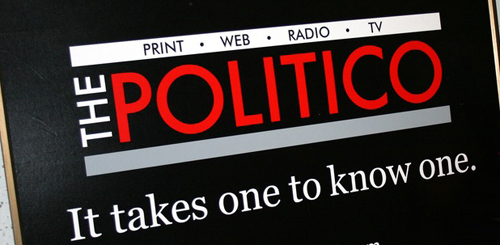POLITICO to Charge More in Places Where It’s Less Popular
POLITICO is joining the stampede toward metered paywalls. In a twist, it will remain free in regions where it's most popular.
POLITICO is joining the stampede toward metered paywalls. In a twist, it will remain free in regions where it’s most popular.
Bylan Byers (“POLITICO to test metered paywall”):
POLITICO today announced that it will start testing a metered subscription system in six states and internationally. For at least six months, those readers will be required to pay for content after consuming a set number of pages on the website. POLITICO will test different price points and page limits “to find the sweet spot for our readership.”
The experiment will go into effect next week in the states of Iowa, North Dakota, Vermont, Mississippi, New Mexico and Wyoming.
From the memo to staff members:
We believe that every successful media company will ultimately charge for its content, using a variety of price points and methods, so it is very important we build real metrics to see how this trend will play out on POLITICO. The result will also help inform future decisions on other investments the company hopes to make in the media space.
Here is how the experiment will work: Readers overseas and in six states will be required to pay for our content after consuming a set number of pages of it, much like they do when visiting The New York Times, The Boston Globe and scores of other news sources. We will experiment with a few different price points and page limits to find the sweet spot for our readership. We chose smaller states, spread across the country, so our experiment captures any regional trends and also limits any potential loss of traffic to the site. This will last at least six months, so we have a large enough sample to appraise the results.
The decision to test a broader subscription model represents a shift in our thinking. As recently as a few months ago, we thought it was premature for POLITICO to start asking readers to pay for content, outside of Pro. But, it is increasingly clear that readers are more willing than we once thought to pay for content they value and enjoy. With more than 300 media companies now charging for online content in the U.S., the notion of paying to read expensive-to-produce journalism is no longer that exotic for sophisticated consumers. This is a very promising, if uncertain, trend in our country. The collective decision by media companies to give away for free a product of high value and high cost will go down as one of the worst, self-defeating moves in the history of industry.
Except that this had long been the model. Daily newspapers, including the Washington Post, are offered at extremely low subscription prices so that they can have maximum distribution and rely on advertising revenues to sustain the operation. Alas, the availability of massive amounts of constantly-updated material online diminished the value in having a print subscription. Indeed, I ended my WaPo subscription years ago and would have done it years sooner if my late wife didn’t want the Sunday inserts.
The most unique aspect of POLITICO is that unlike other media companies, we often sell out our ad inventory in the Washington, D.C., market because demand for our ad space is so high. This means it’s highly unlikely we would ever institute a metered system in the D.C. area. The economics wouldn’t work because every company that has put a subscription system in place has seen some decrease in traffic, as you might expect. We want and need that traffic in D.C. because the desire of advertisers to reach our elite audience here is exceptionally strong. For you non-business folks, that is a very good problem to face.
Outside of Washington, what we will look for with this experiment is whether or not we can bring in more revenue through paying subscribers than we lose as a result of any decline in traffic. This is a fairly straightforward calculation – and one that will instruct our future thinking in this area.
So, amusingly, the place with the highest concentration of political wonks who want to read POLITICO is therefore the place where the advertising model still supports the operation. Out in the hinterlands, where most people reasonably view the daily machinations of Washington pols as tedious, the relatively few people interested in reading POLITICO will have to be punished.
It’s a strange world.





Conservatives are bad at math, part LVII
A paywall? In 2013? Can we even call it “wall?” More like a few Popsicle sticks held together with glue. Perhaps politico has never heard of services like Pulse and the Memeorandum, which is odd, since both link to politico content on a regular basis. Politico will simply train these users to avoid their site completely = no ad clicks, either.
Paywalls = Still Getting Our IT Advice From Those Over 50.
@James in Silverdale, WA: More and more sites are doing paywalls and seem to have figured out how to make it work. I’m still balking at it and do not subscribe to any news site, although I do pay for Foreign Affairs, National Interest, and a couple others. I also subscribe to TPM and Sullivan to support their enterprises.
@James Joyner: “seem to have figured out how to make it work”
Making it “work” means they are at least breaking even. This, of course, has nothing to do with news-gathering, or the quality of it. News sites especially have no business erecting paywalls here in the Era of Completely Optional Facts While Feeding This Ad. There is nothing politico provides that cannot be found elsewhere, paywalls or not. I routinely see content allegedly hidden behind paywalls. They are money-making tools, nothing more. They are not in any way gate-keepers.
Your opting to pay for services which give you value better approximates actual free enterprise.
Boy, if Politico is going to charge more in place where it’s not popular, it’s going to run in the millions in my house…
I hope they put the entire site behind a pay wall, and then charge a lot for access!
With such low readership in those states, any unusual political (or local) event will cause a rash of page hits and will skew the whole thing.
The underlying problem here is that someone has to pay for internet sites to exist, and the traditional “free lunch paid for by advertising” model doesn’t appear to be sustainable. The paywall model seems insane when you have competitors who give it away for free, but as more and more of those free competitors go bankrupt, at some point one of the paywall providers is going to be the last man standing.
@James Joyner:
I agree with the first part, but the second part has yet to be demonstrated. I think it’s notable that most of these sites have adopted what they call a “freemium” model with what amount to arbitrary limits.
If I remember correctly, Sullivan struggled to reach his subscription target this year and next year, it’s going to be twice as hard. I also predict that next year, maybe two years from now, we’ll be hearing a lot about how the “freemium” model doesn’t work, even at $20 a year.
@Stormy Dragon: “but as more and more of those free competitors go bankrupt, at some point one of the paywall providers is going to be the last man standing.”
The assumption here is that in order for information to be freely available, someone must therefore be making money from it. This is not inevitable, and is far from the case today. Information accumulates in many diverse places around the internet. Beyond a certain point, the cost of keeping this data online plateaus quickly even as more data is added, thanks to cheap and getting cheaper storage. Libraries, universities, trade organizations, support forums, fan sites, wikis, news aggregators…
Once this data is searchable, the purpose of a paywall as gate-keeper fades away. No one paywall provider can possibly keep up with the mountain of data this is now free and will remain so. If the temptation is to sue, then we’re back to badgering customers with lawsuits which do nothing to stem the actual tide.
One big paywall that is probably in its last decade of dominance is the ISP. The growing network of always-on devices will ultimately render them redundant. The ongoing warrantless data-mining operation perpetrated by our government fuels demand for these networks to become strongly encrypted.
I think of the trend towards paywalls as being the rectification of a mistake. Most newspapers really should have never tried putting all their stuff online for free in the first place, although I don’t blame them too much – they had no way of knowing how little web advertisements would end up bringing in revenue to anyone who wasn’t an aggregator.
@James in Silverdale, WA:
Information is cheap. Knowledge is expensive.
FWIW:
Paywalls are as out of place today as fins on the trunk of a Chevy. The capitalist model will not apply to it. The sooner State and Federal govt recognize this and treat it like the Interstate Highway system…the better.
@Pharoah Narim: I don’t understand what that means. You propose having the state and federal governments take over newspapers? Subsidize newspapers?
@James Joyner: Sorry for the ambiguity. No– the long haul circuits of the WWW and the local points of presence that allow individuals access to the super highway should, at this stage in its maturity, be viewed as public utilities. Its not the middle/upper class past time it started out as. I should get a bill for it same as I get a water bill from the city.
@Pharoah Narim: I don’t have any great heartburn with Internet delivery as a public utility and have some strong sympathy for the idea (I haven’t much explored the practical policy implications) of free wireless everywhere as a taxpayer-funded good. But I’m not sure how that applies to the issue of newspaper gateways. Content providers and delivery systems are different animals.